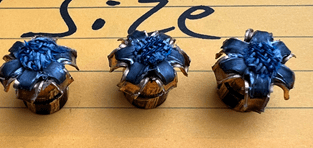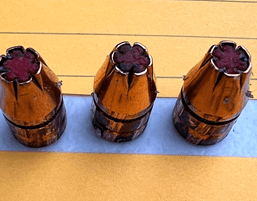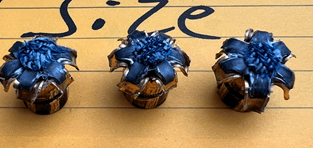Unexpected Outcomes
How ballistic gel can make you question what you have been told!

Growing up in Mississippi, I was introduced to shooting at a relatively young age. My first gun was an air rifle and every tin can suddenly become a target for me and my BB gun! My grandmother encouraged my interest in shooting and actually saved up tin cans and milk cartons for me to shoot. Later I graduated to my grandfather’s single shot bolt action .22LR, and while I never did develop a passion for hunting, I enjoyed target shooting very much. As I entered my teenage years my dad introduced me to the 1911. Dad was in the Army in the 1950s and 1960s and he assured me the 1911 chambered in .45 ACP was the only pistol I would ever need. So, when it was time to buy my first pistol, I purchased my very own Colt 1911 Government model.
My fascination with shooting continued to grow and when the TV Show “Quincy” came out in 1976, where Jack Klugman’s character played a medical examiner who used science and ballistics to solve crimes, the hook was set! Like most people growing up in the South, I thought I knew a lot about guns. I knew how to operate them and how to use them safely, and that you didn’t want to get shot by one. But before actually encountering my first gunshot victim my expectations were defined by what I saw on the big screen. According to the movies and from what I observed by shooting water jugs, being shot in the chest should have been a certain death sentence.
Fast forward to today, and I have spent the past 30+ years working in emergency medicine. Initially as a First Responder with my local volunteer fire department, then as EMT and Paramedic, before starting medical school. After graduating medical school, I did an emergency medicine residency and I have been working in a Level I Trauma Center for 18 years. My first experience with reality of a gunshot victim came as an EMT on the ambulance. When we arrived on the scene, I was not impressed. Here was a guy that had just been shot in the chest, and according to my tainted version of reality he should have died before we ever arrived. Instead, we transported him to the hospital and he was discharged a few days later. When I decided to apply for medical school, I started taking the suggested prerequisite classes which included biology, physics and higher mathematics like calculus. I started having a better understanding of what bullets could and could not do after learning about Newton’s Laws of Motion, the concept of coefficient of friction, kinetic energy and etc. Currently, in addition to being an emergency medicine physician at a Level I Trauma Center, I am also one of several medical providers who support SWAT teams for several different state agencies. One team uses Winchester Ranger 9mm 127g +P+ ammo and the other uses Hornady Critical Duty 9mm 135g +P ammo, which is also reportedly used by the FBI. As a civilian, I wanted to know which was better for my everyday carry ammunition and after reading various ballistic reviews in different magazines, I decided to carry Federal HST 9mm 124g. But I have also read where clothing can prevent a hollow point bullet from expanding and I have seen bullets that have gone through patients that have not expanded. So, I decided the best way for me to determine what to carry would be for me to perform my own ballistic test
The first thing I wanted to do was to get a baseline performance by shooting into 10% bare synthetic ballistic gelatin from Clear Ballistics. On the day of the testing, I was using a full-size SIG P320 with a 4.7-inch barrel (to get maximum velocity from a carry size pistol) and the ambient temperature was approximately 54 degrees.
Initial Bare Gelatin Results
- Winchester Ranger 9mm 127g +P+ penetrated an average of 15 inches in the bare gel with approximately 0.67 inches expansion.
- Hornady Critical Duty 9mm 135g +P penetrated an average of 19 inches in the bare gel with approximately 0.43 inches expansion.
- Federal HST 9mm 124g penetrated an average of 16.5 inches in the bare gel with approximately 0.63 inches expansion.
Next in my testing, I wanted to see if clothing would prevent the hollow points from opening up, so I modeled my test after The International Wound Ballistics Association (IWBA) test which uses four layers of denim. However, I did modify this slightly. The FBI Heavy Clothing test uses a tee shirt, a cotton shirt and Polartec fleece in addition to denim. I went halfway between the two. I used four layers of denim with two layers of tee shirt material in between. The denim was a new pair of Wrangler Rustler jeans from Walmart that had never been washed. The tee shirt was a regular Hanes 50/50 blend tee shirt. As an ER doctor, I see patients during the winter wearing multiple pairs of pants and also wearing basketball shorts, sweatpants and underwear. The FBI conducts their tests from 10 feet. I opted to do my test at less than 6 inches. I wanted the velocity to be as high as possible. While I know that muzzle velocity at the barrel and 10 feet will likely be close to the same, I did not want to take a chance on any reduction in muzzle velocity. Once again, the ambient temperature was approximately 54 degrees.



Based on what I had read before, I wasn’t surprised the Winchester Ranger failed to expand. However, I was very surprised that the Hornady Critical Duty failed to expand. Maybe it was because the gel was approximately 54 degrees and not 70 degrees. Maybe shooting the gel from less than six inches instead of ten feet played a factor. Maybe having tee shirt material in between the layers of jeans played a factor. These results varied somewhat from an earlier, less consistent ballistics test we conducted at Boondocks Firearms Training academy. What I have learned is there is a lot of variables that can alter the effectiveness of a bullet, and this is why many of the top law enforcement instructors and trainers such as Tom Givens, Dave Spaulding and Greg Ellifritz indicate the need to put multiple shots on a threat quickly, because a single round may fail to perform or to incapacitate a threat. However, I was happy to see that the Federal HST under the same conditions did expand. I think I will stick with the Federal HST for now.
For some additional information on Stopping Power and The Effects of Handgun Rounds check out the videos and links



